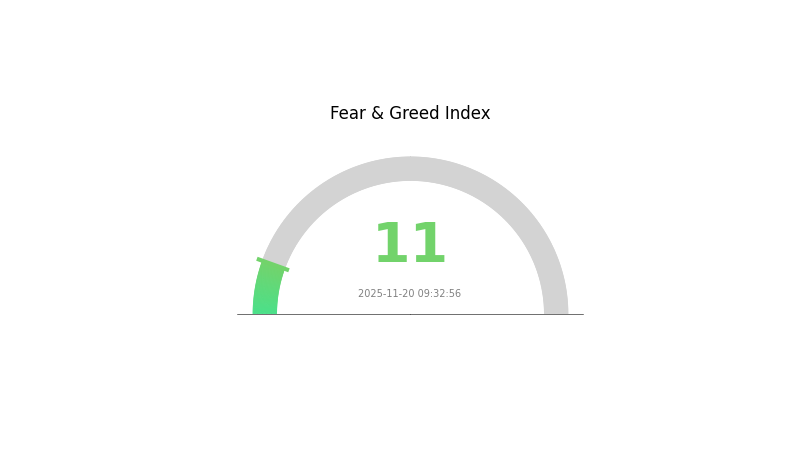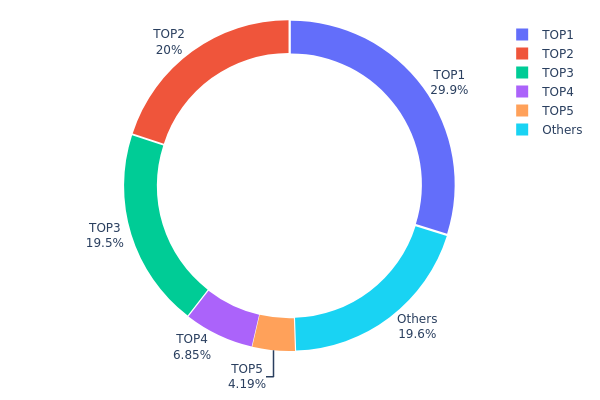2025 KERNEL Price Prediction: Analyzing Market Trends and Growth Potential for the Emerging Cryptocurrency
Introduction: KERNEL's Market Position and Investment Value
KernelDAO (KERNEL), as a restaking ecosystem on Ethereum and BNB Chain, has emerged as a significant player in the DeFi space since its inception. As of 2025, KERNEL's market capitalization has reached $14,356,982, with a circulating supply of approximately 162,317,496 tokens, and a price hovering around $0.08845. This asset, dubbed the "shared security enabler," is playing an increasingly crucial role in enhancing network security, liquidity, and reward generation across multiple blockchain ecosystems.
This article will provide a comprehensive analysis of KERNEL's price trends from 2025 to 2030, taking into account historical patterns, market supply and demand, ecosystem development, and macroeconomic factors, offering investors professional price predictions and practical investment strategies.
I. KERNEL Price History Review and Current Market Status
KERNEL Historical Price Evolution
- 2025: Launch of KernelDAO, price reached all-time high of $0.4998 on April 14
- 2025: Market downturn, price dropped to all-time low of $0.08278 on November 19
KERNEL Current Market Situation
As of November 20, 2025, KERNEL is trading at $0.08845. The token has experienced significant volatility in recent periods:
- 24-hour change: +0.14%
- 7-day change: -23.62%
- 30-day change: -47.44%
- 1-year change: -75.81%
The current market capitalization stands at $14,356,982.52, ranking KERNEL at 1068th position in the global cryptocurrency market. With a circulating supply of 162,317,496 KERNEL tokens out of a total supply of 1,000,000,000, the project has a circulating ratio of 16.23%.
The 24-hour trading volume is $151,886.47, indicating moderate market activity. The token is currently trading 82.29% below its all-time high, suggesting a bearish trend in the short to medium term.
Click to view current KERNEL market price

KERNEL Market Sentiment Indicator
2025-11-20 Fear and Greed Index: 11 (Extreme Fear)
Click to view the current Fear & Greed Index
The crypto market is currently gripped by extreme fear, with the sentiment index plummeting to 11. This level of pessimism often signals a potential buying opportunity for contrarian investors. However, caution is advised as market bottoms can be challenging to predict. Savvy traders might consider dollar-cost averaging or setting conservative buy orders. Remember, market sentiment can shift rapidly, so stay informed and manage your risk carefully. As always, DYOR and only invest what you can afford to lose.

KERNEL Holdings Distribution
The address holdings distribution data for KERNEL reveals a highly concentrated ownership structure. The top address holds 29.85% of the total supply, while the top three addresses collectively control 69.36% of KERNEL tokens. This level of concentration raises concerns about the project's decentralization and potential market manipulation risks.
Such a concentrated distribution can significantly impact market dynamics. The large holdings by a few addresses may lead to increased price volatility if any of these major holders decide to sell or move their tokens. Furthermore, this concentration of ownership could potentially allow for market manipulation or coordinated actions that could affect KERNEL's price and liquidity.
This distribution pattern suggests that KERNEL's on-chain structure may be less stable than ideal for a decentralized project. The high concentration in a few addresses indicates a lower degree of decentralization, which could be a point of concern for investors and users of the KERNEL ecosystem. It's crucial for the project to work towards a more distributed token allocation to enhance its resilience and align with decentralization principles.
Click to view the current KERNEL holdings distribution

| Top | Address | Holding Qty | Holding (%) |
|---|---|---|---|
| 1 | 0xa7cd...7f4290 | 298532.26K | 29.85% |
| 2 | 0x226b...29f5e7 | 200000.00K | 20.00% |
| 3 | 0x52ad...98828b | 195159.72K | 19.51% |
| 4 | 0xf977...41acec | 68478.70K | 6.84% |
| 5 | 0x09fd...c80393 | 41866.93K | 4.18% |
| - | Others | 195962.39K | 19.62% |
II. Core Factors Affecting KERNEL's Future Price
Technical Development and Ecosystem Building
-
Layer 2 Scaling: KERNEL is implementing Layer 2 scaling solutions to improve transaction speed and reduce fees, potentially increasing adoption and user activity.
-
Ecosystem Applications: KERNEL is focusing on developing decentralized applications (DApps) in areas such as decentralized finance (DeFi) and non-fungible tokens (NFTs), which could drive increased usage and value for the network.
III. KERNEL Price Prediction for 2025-2030
2025 Outlook
- Conservative forecast: $0.06525 - $0.08818
- Neutral forecast: $0.08818 - $0.10890
- Optimistic forecast: $0.10890 - $0.12962 (requires positive market sentiment and project developments)
2027-2028 Outlook
- Market phase expectation: Potential growth phase with increasing adoption
- Price range prediction:
- 2027: $0.12441 - $0.17366
- 2028: $0.12282 - $0.16072
- Key catalysts: Project milestones, market trends, and technological advancements
2029-2030 Long-term Outlook
- Base scenario: $0.15617 - $0.17804 (assuming steady market growth)
- Optimistic scenario: $0.17804 - $0.20118 (assuming strong project performance and market conditions)
- Transformative scenario: Above $0.20118 (extreme favorable conditions and widespread adoption)
- 2030-12-31: KERNEL $0.20118 (potential peak based on current projections)
| 年份 | 预测最高价 | 预测平均价格 | 预测最低价 | 涨跌幅 |
|---|---|---|---|---|
| 2025 | 0.12962 | 0.08818 | 0.06525 | 0 |
| 2026 | 0.15029 | 0.1089 | 0.08603 | 23 |
| 2027 | 0.17366 | 0.12959 | 0.12441 | 46 |
| 2028 | 0.16072 | 0.15162 | 0.12282 | 71 |
| 2029 | 0.1999 | 0.15617 | 0.14524 | 76 |
| 2030 | 0.20118 | 0.17804 | 0.16914 | 101 |
IV. KERNEL Professional Investment Strategies and Risk Management
KERNEL Investment Methodology
(1) Long-term Holding Strategy
- Suitable for: Long-term value investors
- Operation suggestions:
- Accumulate KERNEL tokens during market dips
- Participate in KernelDAO's restaking ecosystem
- Store tokens in secure hardware wallets
(2) Active Trading Strategy
- Technical analysis tools:
- Moving Averages: Use to identify trend direction and potential reversals
- RSI (Relative Strength Index): Monitor overbought/oversold conditions
- Key points for swing trading:
- Monitor KERNEL's performance relative to ETH and BNB
- Stay updated on KernelDAO ecosystem developments
KERNEL Risk Management Framework
(1) Asset Allocation Principles
- Conservative investors: 1-3% of crypto portfolio
- Aggressive investors: 5-10% of crypto portfolio
- Professional investors: 10-15% of crypto portfolio
(2) Risk Hedging Solutions
- Diversification: Balance KERNEL with other crypto assets
- Stop-loss orders: Set appropriate levels to limit potential losses
(3) Secure Storage Solutions
- Hardware wallet recommendation: Gate web3 wallet
- Software wallet option: Official KernelDAO wallet (if available)
- Security precautions: Use two-factor authentication, backup private keys securely
V. KERNEL Potential Risks and Challenges
KERNEL Market Risks
- Volatility: High price fluctuations common in crypto markets
- Competition: Emerging restaking projects may impact KERNEL's market share
- Liquidity: Potential challenges in large-volume trading
KERNEL Regulatory Risks
- Uncertain regulations: Evolving crypto policies may affect KernelDAO operations
- Cross-chain compliance: Challenges in adhering to regulations across multiple blockchains
- Staking regulations: Potential regulatory scrutiny on restaking mechanisms
KERNEL Technical Risks
- Smart contract vulnerabilities: Potential exploits in KernelDAO's contracts
- Cross-chain risks: Security concerns related to interoperability features
- Scalability issues: Possible network congestion affecting KernelDAO's performance
VI. Conclusion and Action Recommendations
KERNEL Investment Value Assessment
KERNEL presents a unique value proposition in the restaking ecosystem, with potential for long-term growth. However, short-term volatility and regulatory uncertainties pose significant risks.
KERNEL Investment Recommendations
✅ Beginners: Consider small, long-term positions after thorough research ✅ Experienced investors: Explore active participation in KernelDAO ecosystem ✅ Institutional investors: Evaluate KERNEL as part of a diversified crypto portfolio
KERNEL Trading Participation Methods
- Spot trading: Available on Gate.com and other supported exchanges
- Staking: Participate in KernelDAO's restaking programs
- DeFi integration: Explore yield farming opportunities within the KernelDAO ecosystem
Cryptocurrency investments carry extremely high risks. This article does not constitute investment advice. Investors should make decisions carefully based on their own risk tolerance and are advised to consult professional financial advisors. Never invest more than you can afford to lose.
FAQ
What is the kernel price prediction for 2030?
Based on current trends and market analysis, KERNEL price is predicted to reach around $15 to $20 by 2030, potentially offering significant returns for long-term investors.
What is the price prediction for kernel token in 2025?
Based on market trends and potential growth, the KERNEL token price is predicted to reach around $0.75 to $1.00 by 2025, reflecting a significant increase from its current value.
Which crypto will reach $1000 in 2030?
Bitcoin is the most likely candidate to reach $1000 by 2030, with Ethereum also having a strong potential. Other promising contenders include Solana, Cardano, and Polkadot.
What crypto will 1000x prediction?
While it's impossible to predict with certainty, emerging projects in AI, DeFi, or metaverse sectors could potentially see massive growth. Always research thoroughly before investing.
Share
Content